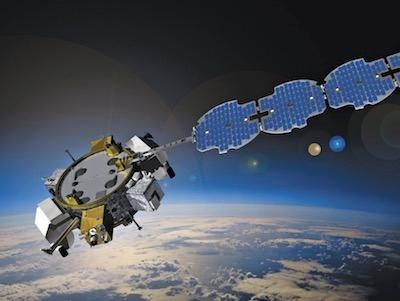Tue, Apr 17, 2018
EAGLE Launched Saturday From Cape Canaveral Air Force Station In Florida
Orbital ATK designed the EAGLE (ESPA Augmented Geostationary Laboratory Experiment) experimental satellite for the U.S. Air Force’s AFSPC-11 mission that successfully launched on United Launch Alliance’s Atlas V vehicle April 14 from Cape Canaveral Air Force Station, Florida. The AFSCPC-11 mission included a second company designed satellite, Mycroft, which is among several Department of Defense experiments hosted on the EAGLE platform as separate payloads.

The EAGLE and Mycroft satellites are based on the company’s ESPAStar™ and ESPASat™ products, which provide modular, cost-effective and highly capable infrastructure resources for hosting technology development and operational payloads. The Orbital ATK-designed EAGLE satellite is the first spacecraft based on the company’s innovative ESPAStar platform. The ESPAStar vehicle can accommodate any combination of up to six hosted or 12 separable, free-flyer payloads in low and geosynchronous orbit and is built to provide an even greater level of access to space. Orbital ATK designed and delivered the EAGLE satellite under a contract with the U.S. Air Force Research Laboratory (AFRL) Space Vehicles Directorate.
After a successful separation from the launch vehicle, EAGLE is hosting several Department of Defense payloads, including Mycroft, the second Orbital ATK-designed satellite to be deployed on the mission. Mycroft, a separable, fly-away experiment, utilized the company’s ESPASat platform for its flight. ESPASat is designed as an affordable GEO bus that can be launched as a secondary payload from an ESPAStar platform.
“Orbital ATK is proud to partner with the U.S. Air Force on the EAGLE and Mycroft missions,” said Chris Long, Vice President, National Security Systems at Orbital ATK. “Our unique capabilities to host separating and non-separating payloads represent a turning point in affordable access to space for small satellites and payloads.”
(Image provided with Orbital ATK news release)
More News
He Attempted To Restart The Engine Three Times. On The Third Restart Attempt, He Noticed That Flames Were Coming Out From The Right Wing Near The Fuel Cap Analysis: The pilot repor>[...]
Make Sure You NEVER Miss A New Story From Aero-News Network Do you ever feel like you never see posts from a certain person or page on Facebook or Instagram? Here’s how you c>[...]
From 2009 (YouTube Edition): Leading Air Show Performers Give Their Best Advice for Newcomers On December 6th through December 9th, the Paris Las Vegas Hotel hosted over 1,500 air >[...]
Aero Linx: NASA ASRS ASRS captures confidential reports, analyzes the resulting aviation safety data, and disseminates vital information to the aviation community. The ASRS is an i>[...]
“For our inaugural Pylon Racing Seminar in Roswell, we were thrilled to certify 60 pilots across our six closed-course pylon race classes. Not only did this year’s PRS >[...]
 NTSB Final Report: Rutan Long-EZ
NTSB Final Report: Rutan Long-EZ ANN FAQ: Turn On Post Notifications
ANN FAQ: Turn On Post Notifications Classic Aero-TV: ICAS Perspectives - Advice for New Air Show Performers
Classic Aero-TV: ICAS Perspectives - Advice for New Air Show Performers ANN's Daily Aero-Linx (06.28.25)
ANN's Daily Aero-Linx (06.28.25) Aero-News: Quote of the Day (06.28.25)
Aero-News: Quote of the Day (06.28.25)



